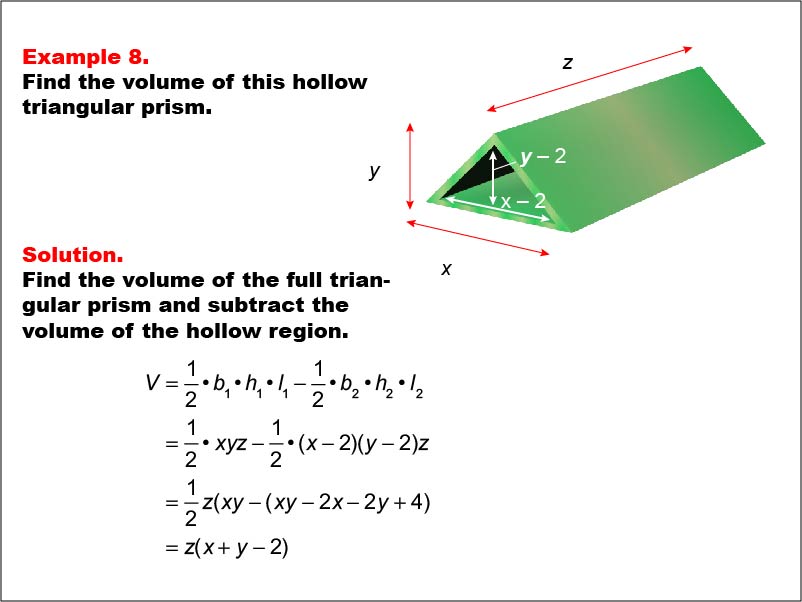
Display Title
Math Example--Volume Concepts--Calculating Volume: Example 8
Display Title
Math Example--Volume Concepts--Calculating Volume: Example 8

Topic
Volume
Description
This image shows a hollow triangular prism with outer dimensions labeled as x, y, and z, and inner dimensions reduced by 2 units each. It demonstrates how to calculate the volume by subtracting the hollow region from the full prism. This image illustrates Example 8: "Find the volume of this hollow triangular prism." The solution uses V = 1/2 * b1 * h1 * l1 - 1/2 * b2 * h2 * l2, which simplifies to V = z(xy - (x - 2)(y - 2)) = z(x + y - 2)..
Volume is a fundamental concept in geometry that helps students understand the space occupied by three-dimensional objects. In this collection, each example uses various geometric shapes to calculate volume, showcasing real-life applications of volume in different shapes.
Seeing multiple worked-out examples allows students to observe different approaches and nuances in calculations, which reinforces their understanding of volume across shapes.
Teacher's Script: Observe this example carefully. Notice the steps taken to find the volume of this particular shape. Can you see how each dimension--length, width, and height--plays a role in determining the overall volume? How might you apply this to other shapes?
For a complete collection of math examples related to Volume click on this link: Math Examples: Volume Collection.
| Common Core Standards | CCSS.MATH.CONTENT.6.G.A.2, CCSS.MATH.CONTENT.7.G.B.6, CCSS.MATH.CONTENT.8.G.C.9, CCSS.MATH.CONTENT.5.MD.C.4, CCSS.MATH.CONTENT.5.MD.C.5.A, CCSS.MATH.CONTENT.5.MD.C.5.B, CCSS.MATH.CONTENT.5.MD.C.5.C |
|---|---|
| Grade Range | 5 - 8 |
| Curriculum Nodes |
Geometry • Surface Area and Volume • Volume |
| Copyright Year | 2013 |
| Keywords | volume |